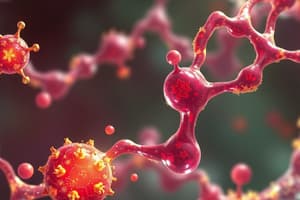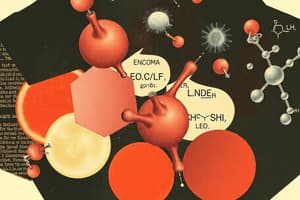Podcast
Questions and Answers
What type of enzyme catalyzes the joining of two molecules using energy from ATP?
What type of enzyme catalyzes the joining of two molecules using energy from ATP?
- Isomerases
- Ligases (correct)
- Hydrolases
- Oxidoreductases
What is the term for the inactive form of an enzyme?
What is the term for the inactive form of an enzyme?
- Apoenzyme
- Zymogen (correct)
- Cofactor
- Holoprotein
Which component is essential for the function of an apoenzyme?
Which component is essential for the function of an apoenzyme?
- Prosthetic group
- Product
- Cofactor (correct)
- Substrate
Which enzyme converts L-alanine to D-alanine?
Which enzyme converts L-alanine to D-alanine?
What is the complete enzyme consisting of the apoenzyme, its cofactor, and coenzyme called?
What is the complete enzyme consisting of the apoenzyme, its cofactor, and coenzyme called?
What defines the active site of an enzyme?
What defines the active site of an enzyme?
What are activators primarily responsible for in enzyme activity?
What are activators primarily responsible for in enzyme activity?
Which of the following is an example of a simple enzyme?
Which of the following is an example of a simple enzyme?
What effect does increasing enzyme concentration have on reaction rate, assuming substrate concentration is constant?
What effect does increasing enzyme concentration have on reaction rate, assuming substrate concentration is constant?
What role do cofactors play in enzyme activity?
What role do cofactors play in enzyme activity?
Which factor has a sharp decreasing effect on enzyme activity when surpassed?
Which factor has a sharp decreasing effect on enzyme activity when surpassed?
What happens to enzyme activity when the pH is extremely high or low?
What happens to enzyme activity when the pH is extremely high or low?
What is the effect of increasing substrate concentration on enzyme activity at first?
What is the effect of increasing substrate concentration on enzyme activity at first?
What is the primary function of an enzyme in a biochemical reaction?
What is the primary function of an enzyme in a biochemical reaction?
Which factor does NOT affect the catalytic process of enzyme activity?
Which factor does NOT affect the catalytic process of enzyme activity?
According to the lock-and-key model, what does the shape of the enzyme dictate?
According to the lock-and-key model, what does the shape of the enzyme dictate?
What characterizes the optimal temperature for enzyme activity?
What characterizes the optimal temperature for enzyme activity?
What is a limitation of the lock-and-key model?
What is a limitation of the lock-and-key model?
How does enzyme concentration typically relate to substrate concentration in a cell?
How does enzyme concentration typically relate to substrate concentration in a cell?
What is the role of the enzyme-substrate complex in enzymatic reactions?
What is the role of the enzyme-substrate complex in enzymatic reactions?
Which model overcomes the limitations of the lock-and-key model?
Which model overcomes the limitations of the lock-and-key model?
How did Michaelis and Menten contribute to the understanding of enzyme reactions?
How did Michaelis and Menten contribute to the understanding of enzyme reactions?
What does the induced-fit model suggest about enzyme activity?
What does the induced-fit model suggest about enzyme activity?
What is formed when an enzyme combines with a substrate during the enzymatic reaction process?
What is formed when an enzyme combines with a substrate during the enzymatic reaction process?
What role do enzymes primarily serve in biochemical reactions?
What role do enzymes primarily serve in biochemical reactions?
What term describes an enzyme in its inactive form?
What term describes an enzyme in its inactive form?
Which statement about enzyme specificity is true?
Which statement about enzyme specificity is true?
What is the term for the combination of an apoenzyme and its cofactor?
What is the term for the combination of an apoenzyme and its cofactor?
Which of the following is an example of a tightly bound coenzyme?
Which of the following is an example of a tightly bound coenzyme?
What happens when a substrate binds to the active site of an enzyme?
What happens when a substrate binds to the active site of an enzyme?
Which characteristic correctly distinguishes coenzymes from cofactors?
Which characteristic correctly distinguishes coenzymes from cofactors?
What is the main purpose of producing enzymes in an inactive form?
What is the main purpose of producing enzymes in an inactive form?
What occurs to the active site of an enzyme in the induced-fit model after the substrate binds?
What occurs to the active site of an enzyme in the induced-fit model after the substrate binds?
What is the primary action of a competitive inhibitor in enzyme inhibition?
What is the primary action of a competitive inhibitor in enzyme inhibition?
Which type of enzyme inhibitor alters the active site without directly competing for it?
Which type of enzyme inhibitor alters the active site without directly competing for it?
What effect does an increase in substrate concentration generally have on enzyme activity if unregulated?
What effect does an increase in substrate concentration generally have on enzyme activity if unregulated?
Which mechanism is NOT one of the four general types of enzyme regulation?
Which mechanism is NOT one of the four general types of enzyme regulation?
What is the outcome when an enzyme's active site is irreversibly altered by a compound?
What is the outcome when an enzyme's active site is irreversibly altered by a compound?
In feedback control, how does an increase in product concentration generally affect enzyme activity?
In feedback control, how does an increase in product concentration generally affect enzyme activity?
What is the role of allosteric control in enzyme regulation?
What is the role of allosteric control in enzyme regulation?
What is the role of a regulator in an allosterically regulated enzyme?
What is the role of a regulator in an allosterically regulated enzyme?
What distinguishes isozymes from one another?
What distinguishes isozymes from one another?
What is the primary function of protein kinases in enzyme regulation?
What is the primary function of protein kinases in enzyme regulation?
What characterizes proteolytic activation of an enzyme?
What characterizes proteolytic activation of an enzyme?
Which of the following is NOT a type of enzyme regulation mentioned?
Which of the following is NOT a type of enzyme regulation mentioned?
What is the significance of enzymes in the human body?
What is the significance of enzymes in the human body?
What modification typically occurs during covalent modification of enzymes?
What modification typically occurs during covalent modification of enzymes?
Which factor can influence enzyme activity?
Which factor can influence enzyme activity?
Flashcards
Enzymes
Enzymes
Biological catalysts that speed up chemical reactions without being consumed in the process.
Substrate
Substrate
The molecule an enzyme acts upon.
Active Site
Active Site
A region on the enzyme that binds the substrate.
Proenzyme or Zymogen
Proenzyme or Zymogen
Signup and view all the flashcards
Cofactor
Cofactor
Signup and view all the flashcards
Coenzyme
Coenzyme
Signup and view all the flashcards
Apoenzyme
Apoenzyme
Signup and view all the flashcards
Holoenzyme
Holoenzyme
Signup and view all the flashcards
What is an activator?
What is an activator?
Signup and view all the flashcards
What is inhibition?
What is inhibition?
Signup and view all the flashcards
What is an inhibitor?
What is an inhibitor?
Signup and view all the flashcards
What is enzyme activity?
What is enzyme activity?
Signup and view all the flashcards
How does enzyme concentration affect enzyme activity?
How does enzyme concentration affect enzyme activity?
Signup and view all the flashcards
How does substrate concentration affect enzyme activity?
How does substrate concentration affect enzyme activity?
Signup and view all the flashcards
How does temperature affect enzyme activity?
How does temperature affect enzyme activity?
Signup and view all the flashcards
How does pH affect enzyme activity?
How does pH affect enzyme activity?
Signup and view all the flashcards
Isomerase
Isomerase
Signup and view all the flashcards
Ligase
Ligase
Signup and view all the flashcards
Proenzyme (Zymogen)
Proenzyme (Zymogen)
Signup and view all the flashcards
Induced-Fit Model
Induced-Fit Model
Signup and view all the flashcards
Enzyme Inhibitor
Enzyme Inhibitor
Signup and view all the flashcards
Competitive Inhibition
Competitive Inhibition
Signup and view all the flashcards
Non-competitive Inhibition
Non-competitive Inhibition
Signup and view all the flashcards
Product Regulation
Product Regulation
Signup and view all the flashcards
Allosteric Regulator
Allosteric Regulator
Signup and view all the flashcards
Enzyme Specificity
Enzyme Specificity
Signup and view all the flashcards
Michaelis-Menten Model
Michaelis-Menten Model
Signup and view all the flashcards
Enzyme-Substrate Complex
Enzyme-Substrate Complex
Signup and view all the flashcards
Lock and Key Model
Lock and Key Model
Signup and view all the flashcards
Product
Product
Signup and view all the flashcards
Isozymes or Isoenzymes
Isozymes or Isoenzymes
Signup and view all the flashcards
Covalent Modification
Covalent Modification
Signup and view all the flashcards
Proteolytic Activation
Proteolytic Activation
Signup and view all the flashcards
What are factors affecting enzyme activity?
What are factors affecting enzyme activity?
Signup and view all the flashcards
What are the six basic enzyme types?
What are the six basic enzyme types?
Signup and view all the flashcards
What are the two common types of enzyme inhibition?
What are the two common types of enzyme inhibition?
Signup and view all the flashcards
What are four general types of enzyme regulation?
What are four general types of enzyme regulation?
Signup and view all the flashcards
Study Notes
Enzyme Overview
- Enzymes are biological molecules, primarily proteins, acting as catalysts
- They speed up reactions without being consumed
- Highly specific, often targeting only one substrate
- Include stereospecificity, the 3D arrangement of atoms in the substrate
- Can exist entirely of protein or with cofactors (metal ions or organic substances)
- Apoenzyme: enzyme lacking cofactor
- Holoenzyme: combination of apoenzyme and cofactor
- Metalloenzyme: apoenzyme + metal ion cofactor
- Prosthetic group: tightly bound coenzyme
Enzyme Classification
- Classified by the Enzyme Commission (EC) of the International Union of Biochemistry
- Numerical system: EC number with four numbers, separating decimal points
- Major class is the first number
- Group the enzyme transfers is the second number
- Destination the transferred group the third number
- Refinement of third number is the last number
- Six basic types based on the reaction type they catalyze
Six Basic Types of Enzymes
- Oxidoreductases: catalyze redox reactions (electron transfer)
- Transferases: transfer functional groups
- Hydrolases: catalyze hydrolysis reactions (using water to break bonds)
- Lyases: catalyze addition to or removal of groups from double bonds
- Isomerases: catalyze isomerization reactions
- Ligases: catalyze linking of two molecules with ATP hydrolysis
Enzyme Structure
- Some enzymes are simple polypeptides (e.g., chymotrypsin, pepsin)
- Others are conjugated proteins with non-protein prosthetic groups (cofactors)
- Apoenzyme: protein portion of enzyme
- Cofactor: non-protein part of enzyme (inorganic or organic e.g., metal ion, coenzyme)
- Holoenzyme: complete enzyme (apoenzyme + cofactor)
- Active site: region on enzyme where substrate binds
- Substrate: molecule that enzyme acts on
Enzyme Inhibition
- Competitive inhibition: inhibitor competes with substrate for active site
- Non-competitive inhibition: inhibitor binds to another site, altering enzyme shape
- Enzyme inhibition can be reversible (inhibitor detaches) or irreversible (inactivates permanently)
Factors Affecting Enzyme Activity
- Enzyme concentration: higher concentration, faster reaction rate
- Substrate concentration: rapid increase then leveling-off
- Temperature: optimal temp, higher rates, higher temp, enzyme denatures
- pH: optimal range, affects enzyme's ionic state, extreme values denature
Studying That Suits You
Use AI to generate personalized quizzes and flashcards to suit your learning preferences.
Related Documents
Description
Explore the fascinating world of enzymes, biological catalysts crucial for speeding up biochemical reactions. Learn about their structure, types, and classification, including the Enzyme Commission's numerical system for identifying various enzymes. This quiz will enhance your understanding of enzyme mechanisms and their specific roles in biological processes.




